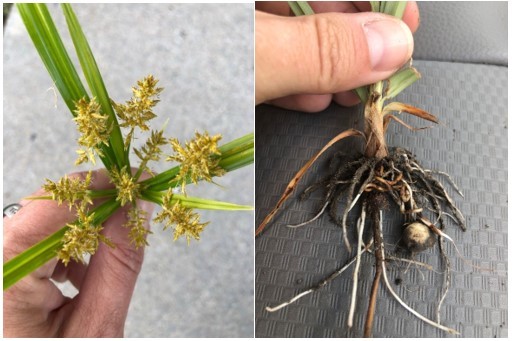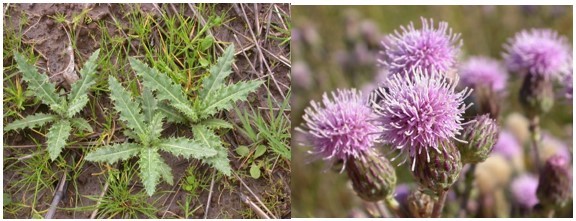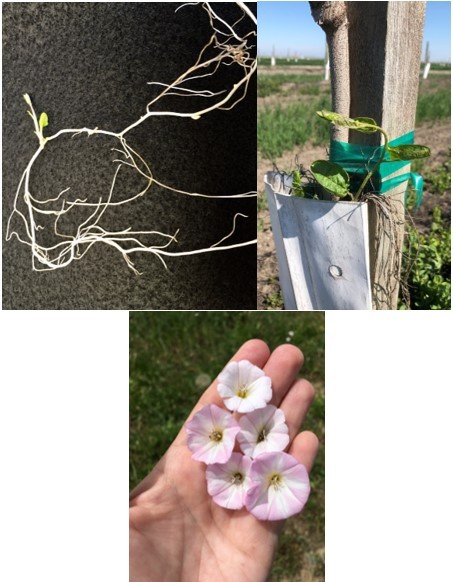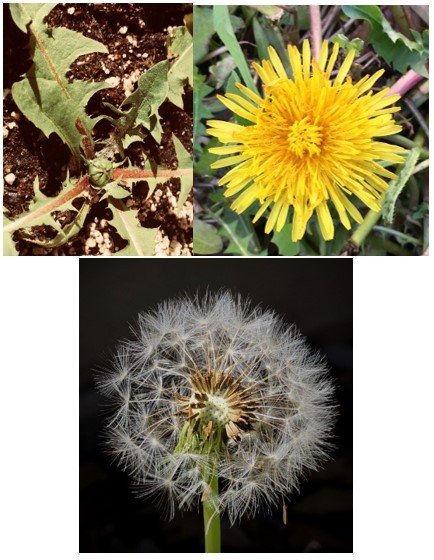Strategies for Dealing with Pesky Perennial Weeds
Mike Basedow, Tree Fruit Specialist
Eastern New York Commercial Horticulture
Strategies for Dealing with Pesky Perennial Weeds
Mike Basedow, ENYCHP and Lynn Sosnoskie, Cornell School of Integrated Plant Science
Perennial weeds can be particularly difficult to manage in the apple orchard. These plants are defined as being able to live for more than two years, which is due to their abilities to produce large root systems or other underground storage structures, such as bulbs, tubers, and rhizomes. These structures facilitate the spread of perennials in orchards, although many species also produce seed that support dispersal.
Perennial weed control begins well ahead of orchard planting, when the field is still fallow. This timing allows orchard managers to make good use of deep, frequent cultivation and herbicides to deplete nutrient reserves stored in the weed's underground structures. This should be followed by the establishment of a strong orchard sod that will prevent weeds from breaking through.
However, no matter how well we prepare the site prior to planting, problematic weeds will always find their way back into the orchard. Thankfully, we can still manage many of these challenging species by being vigilant and strategic with our weed management programs. Let's review management plans for a few of these perennial pests.
Yellow Nutsedge (Cyperus esculentus)

Figure 1. Yellow nutsedge has triangular stems and yellow/gold flowers (A). Nutsedge produces tubers that aid in its dispersal (B). Photos courtesy Dr. Lynn Sosnoskie.
Yellow nutsedge (as the name suggests) is a sedge, which can be differentiated from the grasses by its triangular stems. It has three small leaves at the base of each flower, which are yellow/gold in color (Figure 1A). Yellow nutsedge produces tubers, which are its underground food storage systems, at the end of rhizomes (Figure 1B). These tubers can persist in the soil for up to five years. Multiple daughter tubers can develop from a single parent plant. Nutsedge is difficult to control because it has large energy reserves as well as a prolonged sprouting period.
Cultural tactics, such as planting orchards in well-drained soils, can be an effective strategy for dealing with nutsedge. Once the orchard is established, control programs will need to rely on well-timed herbicide applications. If you have nutsedge in your orchard, you might consider using pre-emergence applications of dichlobenil (Casoron, WSSA Group 20) or multiple applications of halosulfuron (Sandea, WSSA Group 2).
Casoron CS is a microencapsulated liquid product that should be applied to the soil surface from late fall through early spring. It can suppress yellow nutsedge (and other perennial species) and control many annual weeds. The soil should be moist at the time of treatment or else the application should be followed by a rain event so the product is activated. Germinating or emerging species at/below the treated zone will be affected; small (< 2" tall), existing weeds with roots in the herbicidal barrier may also be injured or killed. Casoron 4G is a granular product and can be applied as a soil treatment only between November 15 and February 15 because of volatility loss. Note that Casoron 4G can only be used for nutsedge control in non-crop areas of the orchard.
Sandea can be applied as a single broadcast application to the orchard floor on either side of the row when nutsedge is fully emerged in early to midsummer. Alternatively, two, sequential applications can be made; the first treatment should occur when the initial nutsedge flush has reached the 3-5 leaf stage while the follow-up application would be made during secondary emergence. Pre-emergence applications of halosulfuron will likely only suppress nutsedge. Other residual products like norflurazon (Solicam, WSSA Group 12) and terbacil (Sinbar, WSSA Group 5) may provide suppression to partial control of nutsedge but will likely require multiple years of application before you will see an impact. The same may be true with rimsulfuron (Matrix, WSSA 2), which also has post-emergence activity. Contact post-emergence products, such as paraquat (WSSA Group 22) and glufosinate (Rely, WSSA Group 10), can be used to burn back above ground shoot growth, but this will not kill the below ground tubers. Also note that because nutsedge is not a grass, it will not be managed using WSSA Group 1 herbicides.
Canada Thistle (Cirsium arvense)

Figure 2. Canada thistle rosette of spiny lobed leaves (A), flowers, and seed head (B). Photos courtesy Dr. James Altland, Oregon State University.
Canada thistle is a broadleaf perennial. Canada thistle's root system is extensive; its roots can reach up to 17 feet across and 20 feet deep. Canada thistle forms a rosette of spiny, lobed leaves (Figure 2A), which will emerge from its roots during both a spring and fall growth flush. Canada thistle also spreads through seed dispersal. Seeds germinate about the same time as the spring flush. A single large seed head can produce up to 5000 seeds (Figure 2B), and a new plant can sprout from as little as a single inch of root segment.
There are some pre-emergence herbicides with efficacy against Canada thistle seedlings including dichlobenil and rimsulfuron (Matrix, WSSA Group 2). Clopyralid (Stinger, WSSA Group 4) is an excellent post-emergent material for control of mature thistle. Stinger should be applied to Canada thistle from rosette to bud stage although it cannot be applied during apple bloom. Clopyralid should also be applied to thistle postharvest, but prior to the first frost while the plant is still actively growing and healthy. 2,4-D (another WSSA Group 4) will also provide partial control when used at similar timings. Contact products such as glufosinate (Rely, WSSA Group 10), and group 14 products like pyraflufen-ethyl (Venue) and saflufenacil (Treevix) will also burn down emerged foliage. These contact-only herbicides are not translocated to roots and will only result in shoot death.
Mowing while the plant is flowering will keep Canada thistle from setting new seeds, but no mowing should be done for at least ten days following a systemic herbicide application to ensure chemical movement out of the treated tissues.
Field bindweed (Convolvulus arvensis)

Figure 3. Field bindweed has a creeping root system (A), produces arrowhead-shaped leaves that are simple and alternate (B) and has white or pink, funnel shaped leaves (C). Photos by Dr. Lynn Sosnoskie.
Field bindweed is a perennial broadleaf that spreads by both seed and through its large, creeping root system (Figure 3A). Bindweed's tap roots, which can grow upwards of 30 feet below ground, facilitates its persistence and tolerance of environmental stress and most weed control tactics. Bindweed has arrowhead-shaped leaves that are simple and alternate with a flattened base and a rounded tip (Figure 3B). It has white or pink, funnel-shaped flowers that are one to two inches across (Figure 3C). The species can be confused with another perennial bindweed, Calystegia sepium (hedge bindweed), which produces larger leaves (with a deeply lobed base and pointed tips) and flowers.
Bindweed is best controlled prior to planting through frequent cultivations and systemic herbicide applications. Once the orchard is planted, spring applications of dichlobenil (Casoron, WSSA Group 20) can provide pre-emergence and post emergent seedling control when seedlings are small. Again, be mindful of the timing limitations associated with these products, as spring applications must be made between Nov 15 and Feb 15 for the 4G formulation, and when air temperatures are less than 70°F and before seedlings are two inches tall for the CS formulation. Pre-emergence applications should be followed up with frequent, additional spot treatments of a systemic product. Remember that 2,4-D, an auxinic herbicide, cannot be applied at apple bloom. Contact products like glufosinate (Rely, WSSA Group 10), and group 14 chemistries such as carfentrazone-ethyl (Aim) and pyraflufen-ethyl (Venue) may also be used to burn back foliage. Mowing is rarely an effective strategy for controlling field bindweed as the prostrate vines often grow under the height of a mower deck.
Dandelion (Taraxacum officianale)

Figure 4. Dandelions form a rosette of lobed, irregularly toothed leaves (A), produce large yellow flowers (B), and have globe-like, white seed heads (C). Photos by Dr. Lynn Sosnoskie.
Dandelions propagate by seed and through shoots that grow from the thick, fleshy roots. Dandelions form a rosette of lobed, irregularly toothed leaves close to the ground (Figure 4A), and produce large, yellow flowers (Figure 4B). Dandelions are characterized by their globe-like, white seed heads; individual seeds possess a feathery pappus that allows for wind-dispersal (Figure 4C).
Dandelions are best managed through the use of herbicides, as their low growth and large root systems make mowing ineffective. Pre-emergence products for dandelion seedling control include: indaziflam (Alion, WSSA Group 29), dichlobenil (Casoron, WSSA Group 20), flumioxazin (Chateau, WSSA Group 14), rimsulfuron (Matrix, WSSA Group 2) and terbacil (Sinbar, WSSA Group 5). Some of these products will also provide some partial post-emergence suppression of seedlings, including rimsulfuron (Matrix) and dichlobenil (Casoron). Systemic auxinic products like 2,4-D and clopyralid (Stinger) may provide partial control of the perennial dandelion plants when used following harvest, prior to the first frost. Burndown materials, such as glufosinate (Rely, WSSA Group 10), and the group 14 products pyraflufen-ethyl (Venue) and saflufenacil (Treevix), can also be utilized in the late spring to suppress above ground shoot growth.
A note on glyphosate for perennial weed management
Glyphosate can be an important tool in a perennial weed management program, as it is both non-selective and systemic, allowing it to be translocated from the foliage down into the storage tissues. There are a few key points to keep in mind if you plan to use glyphosate.
- To get the most out of glyphosate's systemic properties, timing is critical. For many weeds, it is best to apply in the spring prior to bud formation up through the flowering period, as this is the period when plants are actively growing and when phloem mobile products are most likely to be translocated to the roots. For yellow nutsedge, the best timing is prior to tuber formation, at about the 5 leaf stage.
- Due to glyphosate's broad spectrum and systemic properties, it must be used with caution to prevent injury to the apple trees. It should only be used in the spring, not beyond early July. Later applications risk uptake by the trees, increasing the potential for sub-lethal damage and winter injury. Every measure should be taken to keep the herbicide from contacting the tree foliage, root suckers, and trunks.
For a full review of the effects glyphosate can have on the apple orchard, we recommend the following Fruit Quarterly article from 2013: http://nyshs.org/wp-content/uploads/2016/10/Pages-23-28-from-NYFQ-Winter-12-12-2013.cmc_.pdf
Always read the label before choosing a product and making an application. Each product has specific product use and tree age restrictions that are pertinent to your operation. Many herbicides can cause damage to trees if they come into contact with sensitive tissues; check labels regarding safe spraying requirements. While some pre-emergence herbicides can control small, emerged, annual weeds, a burn-down herbicide may be required to achieve complete vegetation control. Active ingredients vary with respect to their spectrums of control; reference product labels regarding tank-mixing recommendations. While we make every effort to provide up to date information, remember that ultimately the label is the law.
Strategies for Dealing with Pesky Perennial Weeds (pdf; 3340KB)

Upcoming Events
Wine Sensory Evaluation Workshop
April 26, 2024 : Wine Sensory Evaluation Workshop
Staatsburg, NY
In collaboration with Jeremy Schuster, Viticulture Specialist at the ENYCHP, Dr. Anna Katharine Mansfield and Chris Gerling, Enology Extension Specialists with the Cornell Craft Beverage Institute, will be presenting a wine production-focused, interactive workshop on sensory evaluation.
What is my vine trying to tell me?
May 15, 2024 : What is my vine trying to tell me?
Plattsburgh, NY
Are your grapevines showing signs of discoloration or stunted growth? Don't ignore these warning signs! Join us on May 15th at the Cliton County CCE office to learn about the essential nutrients that grapevines require to thrive, identify the symptoms of nutrient deficiencies, and how to fix them. Don't miss out on this opportunity to improve your grapevine cultivation skills! Attendance is free, but registration is required.
How man's best friend can help find Spotted Lanternfly
May 21, 2024
Millbrook, NY
Come and join us at the Dutchess County CCE office on May 21st for a special demonstration by Jennifer Fimbel, the Agriculture and Horticulture Program Leader with Dutchess County CCE. You will get to see her SLF K9 Cole in action as they demonstrate how man's best friend can be used to detect the Spotted Lanternfly. Attendance is free, but registration is required












































